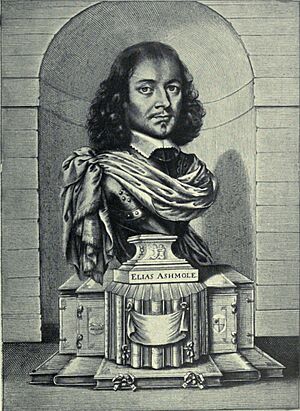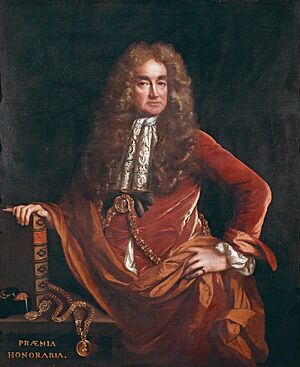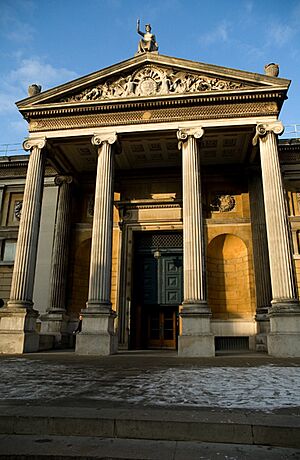Elias Ashmole facts for kids
Quick facts for kids
Elias Ashmole
|
|
|---|---|
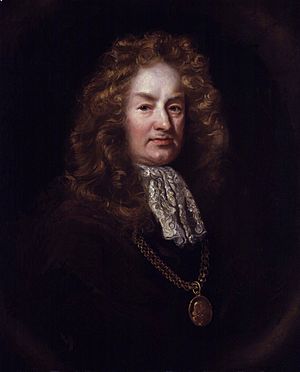
Elias Ashmole by an unknown artist (detail), c. 1688, after the portrait by John Riley, below
|
|
| Born | 23 May 1617 Lichfield, Staffordshire, England
|
| Died | 18 May 1692 (aged 74) Lambeth, London, England
|
| Occupation | antiquarian, politician, officer of arms, astrologer and alchemist |
Elias Ashmole (born May 23, 1617 – died May 18, 1692) was an English antiquary, politician, and astrologer. He was also interested in alchemy, which was an early form of chemistry. Ashmole supported the King's side during the English Civil War. When King Charles II returned to power, Ashmole was given important jobs.
Ashmole loved studying old things and nature. His large library showed his interests. It included books on English history, law, coins, and plants. He was one of the first members of the Royal Society. This group was important for developing modern science. But Ashmole also had interests in old traditions and mystical ideas. He was an early freemason, though we don't know how deeply he was involved.
Throughout his life, Ashmole collected many interesting objects. He got many of these from John Tradescant the Younger, a famous traveler and collector. Ashmole later gave most of his collection, including his books and valuable old papers, to the University of Oxford. This gift helped create the Ashmolean Museum, a famous museum today.
Contents
Early Life and Royalist Support

Elias Ashmole was born on May 23, 1617, in Lichfield, England. His family had been important, but their wealth had lessened by the time he was born. His mother, Anne, came from a rich family. His father, Simon Ashmole, was a saddler and a soldier.
Elias went to Lichfield Grammar School. He also sang in the choir at Lichfield Cathedral. In 1633, he moved to London. He helped the sons of James Paget, a judge. In 1638, with Paget's help, Ashmole became a solicitor, which is a type of lawyer. He had a good law practice in London. In 1638, he married Eleanor Mainwaring, but she died three years later.
When the English Civil War began in 1642, Ashmole supported King Charles I. He left London and lived quietly for a while. In 1644, he became a tax collector for the King in Lichfield. Later, he got a military job in Oxford. He worked as an officer for the King's army. In his free time, he studied math and physics. He also became very interested in astronomy, astrology, and magic.
In 1645, he moved to Worcester as a tax collector. He also became a captain in a Royalist army group. However, he mostly worked with artillery and did not fight in battles.
After the War and Freemasonry
After Worcester surrendered in 1646, Ashmole went back home. He learned his mother had died from the plague. Around this time, he became a freemason. His diary entry from October 16, 1646, says he was "made a Free Mason at Warrington."
He mentioned attending a meeting again in 1682. He wrote that he was the "Senior Fellow among them." This was 35 years after he first joined. Ashmole's notes are some of the earliest records of Freemasonry in England.
A Wealthy Collector
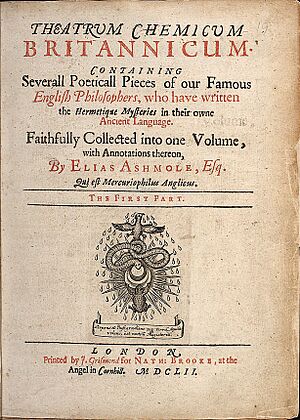
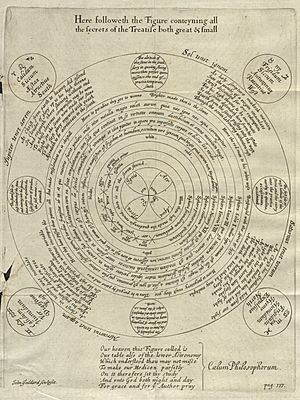
In 1649, Ashmole married Mary, Lady Mainwaring. She was a wealthy widow much older than him. This marriage made Ashmole rich enough to follow his interests. He could study botany and alchemy without needing to earn money.
During the 1650s, Ashmole focused on alchemy. In 1650, he published Fasciculus Chemicus. This book was his English translation of two Latin alchemy books. In 1652, he published Theatrum Chemicum Britannicum. This was a collection of old English poems about alchemy. This book helped save many works that might have been lost. Ashmole seemed more like a collector of alchemy writings than someone who did experiments himself.
His last alchemy book was The Way to Bliss in 1658. After that, he became more interested in other things. Ashmole's books were studied by other thinkers, like Isaac Newton.
Around 1650, Ashmole met John Tradescant the Younger. Tradescant and his father had a huge collection of plants, minerals, and other rare items. Ashmole helped Tradescant organize his collection in 1652. In 1656, Ashmole paid for the catalogue of the collection, called Musaeum Tradescantianum. In 1659, Tradescant gave his collection to Ashmole. This was because Tradescant had lost his only son. Ashmole's strong desire to get the collection has led some to think he was very ambitious.
Rewarding the King's Loyalty
Ashmole worked on other catalogues, including one for the Roman coin collection at the Bodleian Library. This took him eight years to finish. His work was interrupted by the return of King Charles II in 1660. Ashmole's loyalty to the King was well rewarded.
He received several important political jobs. He became a Commissioner and then Comptroller for the Excise in London. This job made him responsible for a large part of the King's money. These positions gave him a lot of income and influence.
The King also asked Ashmole to create a catalogue of coins and medals in the Royal Collection. Ashmole also helped organize the King's coronation.
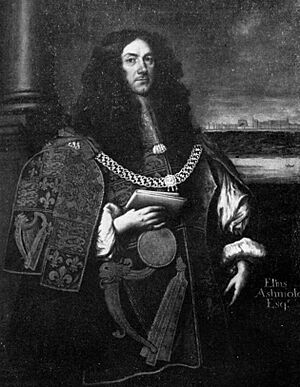
In 1661, Ashmole became one of the first members of the Royal Society. However, he was not very active in the group. His most important job was at the College of Arms. In June 1660, he became Windsor Herald of Arms in Ordinary. In this role, he studied the history of the Order of the Garter. He had been interested in this group since the 1650s.
In 1672, he published The Institution, Laws and Ceremonies of the Most Noble Order of the Garter. This was a large book with pictures by Wenceslaus Hollar. Ashmole had spent years researching it. This book made him a leading expert on the Order of the Garter. He wrote much of it in 1665 to escape the Great Plague in London.
On April 1, 1668, Lady Mainwaring died. On November 3, 1668, Ashmole married Elizabeth Dugdale. She was the younger daughter of his friend, Sir William Dugdale. In 1675, Ashmole left his job as Windsor Herald. He was offered a higher position, but he turned it down for Dugdale.
Ashmole had his own coat of arms. After the King returned, Ashmole was given a new crest. It showed the god Mercury and the constellation Gemini. This reflected his interest in astrology.
Ashmole was a supporter of the Church of England. He gave new prayer books to Lichfield Cathedral. Some people called Ashmole a Rosicrucian, which was a secret society. However, others said he was not. Ashmole's interest in these groups might have been social or just part of his study of old things. But the idea of a place holding all knowledge might have inspired him to create a great museum.
The Ashmolean Museum
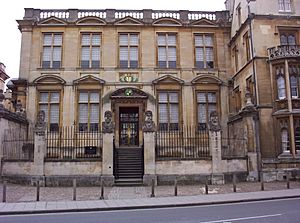
In 1669, Ashmole received a special degree from the University of Oxford. He kept his connections with the University. In 1677, Ashmole gave the Tradescant Collection to the University. He also added his own collected items. He had one condition: a proper building had to be built to keep the collections and show them to the public.
The Ashmolean Museum was finished in 1683. Many people consider it the first truly public museum in Europe. When the collection was moved to Oxford, it filled twelve wagons. A large part of Ashmole's own collection was destroyed in a fire in 1679. This included many old objects, books, and coins. Because of the fire, the collection had more items from the Tradescants than Ashmole had planned.
Ashmole's health began to get worse in the 1680s. He continued to hold his tax office until he died. He started writing notes about his life in a diary. These notes give us a lot of information about him and his time.
Elias Ashmole died at his home in Lambeth on May 18, 1692. He was buried on May 26. Ashmole left the rest of his collection and library to Oxford for the Ashmolean Museum. Most of his books are now in the Bodleian Library at Oxford.
Historians describe Ashmole as an antiquary first. He understood the value of new science, which he supported through his museum. His greatest passion was studying old things. He was also very ambitious. His work on old documents is still valuable today. His alchemy books, especially Theatrum Chemicum Britannicum, saved many works that might have been lost.
Images for kids
-
Ashmole's birthplace in Lichfield
-
Theatrum Chemicum Britannicum (1652), Ashmole's collection of alchemical poems
-
George Ripley's Wheel, from Theatrum Chemicum Britannicum, 1652
-
Elias Ashmole wearing a tabard as Windsor Herald, painted by Cornelis de Neve in 1664
-
The Old Ashmolean Building, now the Museum of the History of Science
See also
 In Spanish: Elias Ashmole para niños
In Spanish: Elias Ashmole para niños


